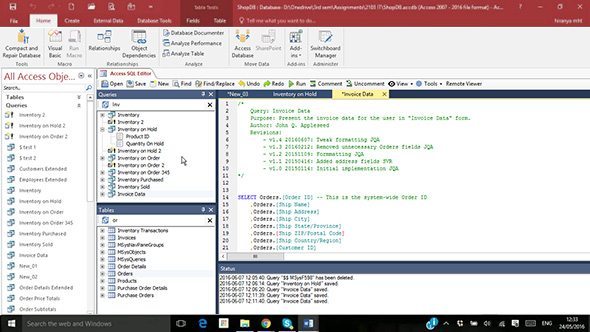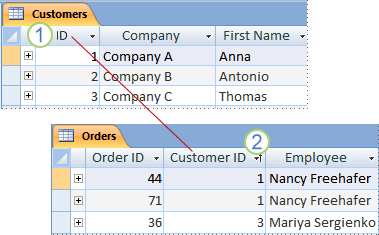Generate Primary Key In Excel

Generate Primary Key In Excel Template
You can define a primary key in SQL Server by using SQL Server Management Studio or Transact-SQL. Creating a primary key automatically creates a corresponding unique clustered index, or a nonclustered index if specified as such.
- A primary key column is identified by a primary key symbol in its row selector. If a primary key consists of more than one column, duplicate values are allowed in one column, but each combination of values from all the columns in the primary key must be unique.
- Aug 31, 2010 I need to generate a unique 8-digit number for a database field to be used as an employee ID. This field is used in course registrations. Will serve as a temporary number for incoming employees, a.
- If you want AppSheet to generate the primary key for you, please check this article instead. If you want to generate a unique value via a formula in the spreadsheet, read the instructions below. The following spreadsheet formula, suitable for Microsoft Excel and Google Sheets, will generate a unique ID consistent with those generated by AppSheet's UNIQUEID function.
- Re: Creating a Primary Key using VBA. I have only got as far as creating the new table, which has no primary key, by running a Public Function called by each of the sub Functions creating the Master tables which mainly consists of a couple of SQL statements.
- Nov 02, 2016 Excel does not let you define a primary key. The best way to accomplish the primary key feature you will see in a relational database is create a unique ID column for your data (or use a combination of values in your list of data to act as the primary key).
- The PRIMARY KEY constraint allows you to define a primary key of a table when you create or alter table. 1) Define a PRIMARY KEY constraint in CREATE TABLE. Typically, you define the primary key for a table in the CREATE TABLE statement. If the primary key has one column, you can use the PRIMARY KEY constraint as a column constraint.
Oct 11, 2017 Hi @themurf47. Yes, that is possible. PowerApps could take use of the SQL Server table as the data source, or the SharePoint list, both of them contains feature to generate Auto-Increment-ID. Like SQL table Primary Key, or the SharePoint List ID field, which can't be modified by users.
Before You Begin
Limitations and Restrictions
A table can contain only one PRIMARY KEY constraint.
All columns defined within a PRIMARY KEY constraint must be defined as NOT NULL. If nullability is not specified, all columns participating in a PRIMARY KEY constraint have their nullability set to NOT NULL.
Windows server 2008 r2 enterprise key generator. Windows Server 2008 r2 Enterprise Serial Number 2018 + Key (Keygen, License) Generator and Activator use the button below to download it. Windows Server 2008 R2 is a server operating system produced by Microsoft.
Security
Permissions
Creating a new table with a primary key requires CREATE TABLE permission in the database and ALTER permission on the schema in which the table is being created.
Creating a primary key in an existing table requires ALTER permission on the table.
Using SQL Server Management Studio
To create a primary key
- In Object Explorer, right-click the table to which you want to add a unique constraint, and click Design.
- In Table Designer, click the row selector for the database column you want to define as the primary key. If you want to select multiple columns, hold down the CTRL key while you click the row selectors for the other columns.
- Right-click the row selector for the column and select Set Primary Key.
Caution
If you want to redefine the primary key, any relationships to the existing primary key must be deleted before the new primary key can be created. A message will warn you that existing relationships will be automatically deleted as part of this process.
A primary key column is identified by a primary key symbol in its row selector.
If a primary key consists of more than one column, duplicate values are allowed in one column, but each combination of values from all the columns in the primary key must be unique.
If you define a compound key, the order of columns in the primary key matches the order of columns as shown in the table. However, you can change the order of columns after the primary key is created. For more information, see Modify Primary Keys.
Using Transact-SQL
To create a primary key in an existing table
The following example creates a primary key on the column TransactionID in the AdventureWorks database.

To create a primary key in a new table
The following example creates a table and defines a primary key on the column TransactionID in the AdventureWorks database.
To create a primary key with clustered index in a new table
The following example creates a table and defines a primary key on the column CustomerID and a clustered index on TransactionID in the AdventureWorks database.
See Also
If you want AppSheet to generate the primary key for you, please check this article instead.Â
If you want to generate a unique value via a formula in the spreadsheet, read the instructions below.Â
The following spreadsheet formula, suitable for Microsoft Excel and Google Sheets, will generate a unique ID consistent with those generated by AppSheet's UNIQUEID() function:
An ID must be a value, not a formula, though, so copy (Ctrl+C) and paste as plain text (Shift+Ctrl+V) the result of the formula calculation into the cell meant to contain the new ID. That's all there is to it!
Unique Key
For example, to generate a set of new IDs in column A for rows 2 through 10:
Excel Generate Rows
- Copy (Ctrl+C) the formula above.
- Paste (Ctrl+V) into the first cell of the target range (A2).
- Observe the cell now has the formula that generates a unique ID and a unique ID value.
- Copy (Ctrl+C) the same first cell of the range (A2).
- Paste (Ctrl+V) into all cells in the range (A2:A10).
- Observe each cell now has the formula that generates a unique ID and its own unique ID value.
- Copy (Ctrl+C) all the same cells in the range (A2:A10).
- Paste as plain text (Shift+Ctrl+V) into the very same cells in the range (A2:A10).
- Observe the formula in each cell has been replaced with the unique ID the formula had generated, rendering the ID permanent.